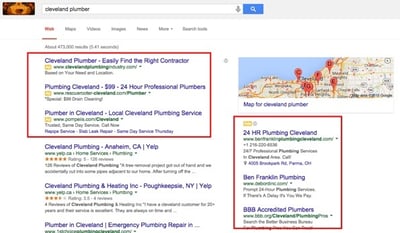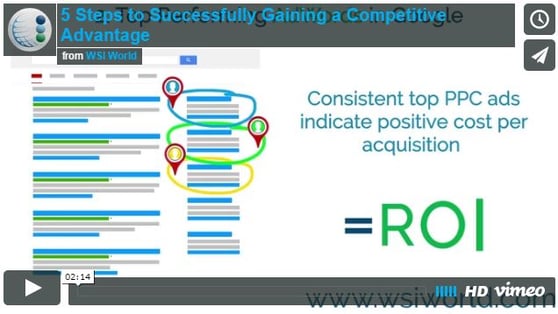Gaining a competitive advantage is essential when you have competitors. One of the most practical ways to run a successful business is to operate under the assumption that your competitors are always trying to steal your customers. The reason? Because it's true. We just discussed the sky-high number of companies that are formed each year, and yet many businesses choose to reside in a blissful fantasy bubble where smarter entrepreneurs aren't using technology and innovation to find a competitive edge. Not only do you need to be aware of your competitors and how they're trying to steal your customers, but you also need to be self-aware of your company's standing within its niche.
To address these concerns, the latest entry in our Digital Marketing Video Series is called 5 Steps to Successfully Gaining a Competitive Advantage. We're at the point where the business world is fully intertwined with the digital space, which means it moves at the same breakneck speed as the Internet. The truth, if you're willing to admit it, is that some of your competitors are doing a better job managing their digital presence than you. But that doesn't mean you can't figure out what they're doing, add to it, and get better results, so here's how:
1. Search Engine Visibility
The easiest way to determine who your top online competitors are is to do a Google search using a phrase that best describes your business. If you're a regional paper company in Scranton, you might search...just kidding, we couldn't resist! If you're a plumber in Cleveland, you'd search "Cleveland plumber" and find a good starter list of companies that you need to keep your eye on. If you want to dig a little deeper for information on which of your competitors is actively building links through third-party outreach and publishing, look into the tools over at Moz or Majestic. Alternatively, if you don't have time to mess around with learning curves, ask a WSI digital marketing expert to perform a WebScan analysis of your business.
2. Top Performing AdWords in Google
Another aspect of Google's search engine results pages (SERPs) that you can mine for data on your competitors are the AdWords for phrases and keywords associated with your business. Using the "Cleveland plumber" example, we get a good idea of which companies show evidence of digital marketing savvy and are therefore worth analyzing:

3. Top Performing Keywords
Using the information you uncovered in #1 and #2, you can begin to form a list of keywords and phrases that your competitors are using to appear ahead of you in the search results. At this point, you have a decision to make. If it doesn't seem like there's a lot of content or competition around the top-performing keywords, you could certainly try to outrank your competitors for these terms. However, if there's a lot of action and history with the top companies and their keywords, it's more efficient to use different, less competitive keywords that will be easier to rank for (but deliver similar traffic).
4. Best Performing Content
Once you know what keywords you're going to focus on, you'll need to create compelling content that readers find useful and interesting. To generate ideas, you can again look at what your competitors are doing with content marketing (and maybe, more importantly, what they aren't doing). We wrote a post last year about using BuzzSumo to analyze top-performing content, which is relatively easy to do and delivers tons of useful data.
5. Social Media Engagement
This one builds on the research you've started doing for #4 with BuzzSumo. Expand on things by visiting your competitors' social profiles to monitor their engagement levels and to see what kind of social posts are moving the needle for them. If you really want to get inside their social thought process, engage with them as a mock customer to gather information about what their customer experience is like and how attentive they are to their social presence. When it's all said and done, don't forget to bring all this information back to your team and figure out how you can develop a more engaging social footprint than your best competitor!
What Is Sustainable Competitive Advantage?
Sustainable competitive advantage refers to a long-term edge that a company holds over its competitors, which allows it to generate a greater value for the company and its shareholders. Sustainable competitive advantage strategies are:
- Value creation involves offering products or services that are perceived as more valuable to customers than what competitors offer.
- Uniqueness such as superior technology, a skilled workforce, brand reputation, or strong customer relationship. This may have a competitive advantage in the marketplace.
- It is not easily replicated by competitors.
- Sustainable competitive advantages are durable over time, often built through long-term planning and investment.
- It's aligned with the company's overall strategy and contributes to it achieving its business objectives.
- The ability to adapt and evolve can be a sustainable competitive advantage.
Types Of Competitive Advantage
These are the types of competitive advantage in business. Cost leadership allows a company to become the most cost-efficient in its industry, providing the leverage to either price lower than competitors or earn higher profits. Differentiation offers a unique value proposition through superior product quality, features, or service, justifying premium pricing. Niche or focus strategy targets a specific market segment, offering solutions that better meet the needs of that niche than broader-market competitors. Innovation-driven competitive advantage arises from developing new products or services. Operational effectiveness, another type, is about performing business activities more efficiently than rivals. Customer orientation focuses on meeting and adapting to customer needs, often through high-quality service. Sustainable practices, increasingly important in today's market, involve environmentally and socially responsible operations, appealing to a growing segment of eco-conscious consumers. Lastly, a strong brand or reputation can significantly attract and retain customers, enabling premium pricing and loyalty based on perceived value.
Competitive Advantage Examples:
Apple's Brand has built a competitive advantage through its strong reputation and continuous innovation in technology. Another one is Amazon, which has a highly efficient supply chain and logistic system. They manage to deliver a wide array of products quickly and reliably. Google's dominance in search and data analytics allows it to generate significant advertising revenue and continually refine its services.
If you need any assistance in gaining a competitive advantage, do not hesitate to contact WSI.






